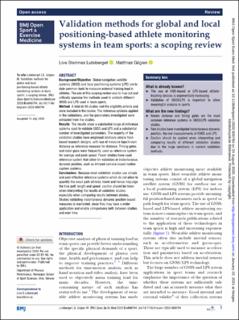| dc.contributor.author | Luteberget, Live | |
| dc.contributor.author | Gilgien, Matthias | |
| dc.date.accessioned | 2021-02-02T10:07:01Z | |
| dc.date.available | 2021-02-02T10:07:01Z | |
| dc.date.created | 2020-10-31T18:20:54Z | |
| dc.date.issued | 2020 | |
| dc.identifier.citation | BMJ Open sport & exercise medicine. 2020, 6(1), Artikkel e000794. | en_US |
| dc.identifier.issn | 2055-7647 | |
| dc.identifier.uri | https://hdl.handle.net/11250/2725743 | |
| dc.description | This is an open access article distributed in accordance with the Creative Commons Attribution Non Commercial (CC BY-NC 4.0) license, which permits others to distribute, remix, adapt, build upon this work non-commercially, and license their derivative works on different terms, provided the original work is properly cited, appropriate credit is given, any changes made indicated, and the use is non-commercial. See: http://creativecommons.org/licenses/by-nc/4.0/ | en_US |
| dc.description.abstract | Background/Objective: Global navigation satellite systems (GNSS) and local positioning systems (LPS) are to date common tools to measure external training load in athletes. The aim of this scoping review was to map out and critically appraise the methods used to validate different GNSS and LPS used in team sports. Method: A total of 48 studies met the eligibility criteria and were included in the review. The reference systems applied in the validations, and the parameters investigated were extracted from the studies. Results: The results show a substantial range of reference systems used to validate GNSS and LPS and a substantial number of investigated parameters. The majority of the validation studies have employed relatively simple field-based research designs, with use of measure tape/known distance as reference measure for distance. Timing gates and radar guns were frequently used as reference system for average and peak speed. Fewer studies have used reference system that allow for validation of instantaneous dynamic position, such as infrared camera-based motion capture systems. Conclusions: Because most validation studies use simple and cost-effective reference systems which do not allow to quantify the exact path athletes travel and hence misjudge the true path length and speed, caution should be taken when interpreting the results of validation studies, especially when comparing results between studies. Studies validating instantaneous dynamic position-based measures is warranted, since they may have a wider application and enable comparisons both between studies and over time. | en_US |
| dc.language.iso | eng | en_US |
| dc.title | Validation methods for global and local positioning-based athlete monitoring systems in team sports: a scoping review | en_US |
| dc.type | Peer reviewed | en_US |
| dc.type | Journal article | en_US |
| dc.description.version | publishedVersion | en_US |
| dc.rights.holder | © Author(s) (or their employer(s)) 2020. | en_US |
| dc.source.pagenumber | 11 | en_US |
| dc.source.volume | 6 | en_US |
| dc.source.journal | BMJ Open sport & exercise medicine | en_US |
| dc.source.issue | 1 | en_US |
| dc.identifier.doi | 10.1136/bmjsem-2020-000794 | |
| dc.identifier.cristin | 1843828 | |
| dc.description.localcode | Institutt for fysisk prestasjonsevne / Department of Physical Performance | en_US |
| cristin.ispublished | true | |
| cristin.fulltext | original | |
| cristin.qualitycode | 1 | |
